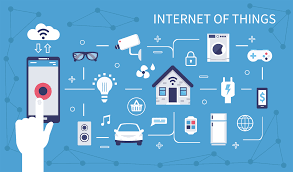IoT stands for the Internet of Things. It refers to the network of physical objects, or "things," embedded with sensors, software, and other technologies that enable them to connect and exchange data with other devices and systems over the internet. These objects can range from everyday household items like smart thermostats and wearable devices to industrial machines, vehicles, and infrastructure components.
The primary goal of IoT is to enable these connected devices to collect, exchange, and analyze data in real-time, leading to improved efficiency, automation, and decision-making. Some common examples of IoT applications include:
1. Smart Home: IoT devices like smart lights, door locks, and security cameras enable homeowners to control and monitor their homes remotely using smartphones or voice commands.
2. Industrial IoT (IIoT): IoT sensors and devices are used in industrial settings to monitor equipment health, optimize processes, and improve productivity. Examples include predictive maintenance of machinery and real-time monitoring of production lines.
3. Smart Cities: IoT technologies are deployed in urban environments to manage infrastructure more efficiently, improve public services, and enhance sustainability. Applications include smart traffic management, waste management, and environmental monitoring.
4. Healthcare: IoT devices such as wearable fitness trackers, remote patient monitoring systems, and smart medical devices enable healthcare providers to monitor patients' health remotely, deliver personalized treatments, and improve patient outcomes.
5. Agriculture: IoT sensors deployed in fields can monitor soil moisture levels, temperature, and other environmental factors to optimize irrigation, fertilization, and crop yield.
Devices.
IoT devices encompass a wide range of physical objects embedded with sensors, software, and connectivity capabilities that enable them to collect and exchange data over the internet. Here are some examples of IoT devices across various domains:
1. **Smart Home Devices**:
- Smart thermostats: Devices that regulate home temperature and can be controlled remotely via smartphones.
- Smart lighting systems: LED bulbs and fixtures that can be controlled and automated using smartphones or voice assistants.
- Smart security cameras: Cameras equipped with motion sensors and cloud storage for monitoring homes remotely.
2. **Wearable Devices**:
- Fitness trackers: Devices worn on the body to monitor physical activity, heart rate, sleep patterns, and more.
- Smartwatches: Watches with additional features like notifications, GPS tracking, and health monitoring.
3. **Industrial IoT (IIoT) Devices**:
- Sensors and actuators: Devices deployed in industrial environments to monitor machinery, equipment, and processes in real-time.
- RFID tags: Wireless tags used for tracking and identifying inventory, assets, and products in supply chains and warehouses.
4. **Smart City Infrastructure**:
- Traffic management systems: Sensors and cameras installed on roads to monitor traffic flow, detect accidents, and optimize signal timings.
- Smart meters: Utility meters equipped with IoT capabilities to monitor and manage electricity, water, and gas consumption in homes and businesses.
5. **Healthcare Devices**:
- Remote patient monitoring systems: Devices that enable healthcare providers to monitor patients' vital signs, medication adherence, and other health metrics remotely.
- Smart pill dispensers: Devices that dispense medications according to a prescribed schedule and send reminders to patients.
6. **Agricultural IoT Devices**:
- Soil moisture sensors: Devices placed in fields to monitor soil moisture levels and optimize irrigation.
- Weather stations: Sensors that measure weather conditions like temperature, humidity, and rainfall to help farmers make informed decisions about crop management.
These examples represent just a fraction of the diverse range of IoT devices that are being deployed across various industries and applications to improve efficiency, productivity, and quality of life.

